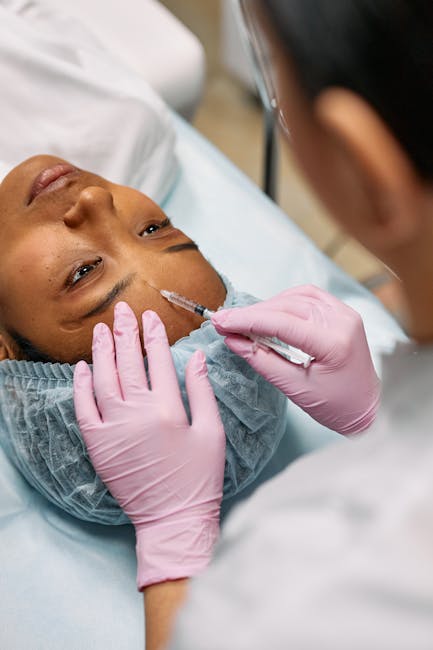Botox vs. Fillers: Which is Right for Your Face?
In the ever-evolving world of cosmetic enhancements, Botox and dermal fillers have become household names. As non-surgical solutions to facial aging, they offer the promise of a youthful appearance without the need for invasive procedures. But how do you decide which one is right for you? In this blog post, we’ll dive into the details of Botox and fillers, helping you make an informed decision about your facial rejuvenation journey.
Understanding Botox
Botox is a popular cosmetic treatment derived from the bacterium Clostridium botulinum. It works by blocking nerve signals in the muscles where it is injected, effectively reducing muscle activity. This leads to a temporary smoothing of fine lines and wrinkles.
How Botox Works
Botox is particularly effective for dynamic wrinkles, which are caused by repeated muscle movements. These include frown lines, forehead creases, and crow’s feet. By relaxing the muscles, Botox helps the skin appear smoother and more youthful.
Benefits of Botox
According to the American Academy of Dermatology, Botox treatments are quick, with minimal downtime and noticeable results within a few days. Studies show that Botox can reduce wrinkles by up to 80%, offering a significant improvement in appearance.
Considerations for Botox
While Botox is highly effective for dynamic wrinkles, it is not suitable for all types of facial concerns. It’s also important to note that the effects are temporary, typically lasting three to six months. Regular maintenance treatments are required to sustain results.
Exploring Dermal Fillers
Dermal fillers, on the other hand, are used to add volume and fullness to the face. They are particularly effective for static wrinkles, which are present even when the face is at rest.
How Dermal Fillers Work
Fillers are gel-like substances injected beneath the skin to restore lost volume, smooth lines, and enhance facial contours. Common types include hyaluronic acid (HA) fillers, calcium hydroxylapatite, and poly-L-lactic acid. Each type serves a unique purpose and offers distinct results.
Benefits of Dermal Fillers
Dermal fillers can tackle a variety of concerns, from plumping thin lips and softening facial creases to improving the appearance of recessed scars and enhancing shallow contours. The effects are immediate and can last from six months to two years, depending on the type of filler used.
Considerations for Fillers
While fillers are versatile, they are not a one-size-fits-all solution. The choice of filler, its placement, and the volume used are crucial for achieving natural-looking results. Consulting with an experienced practitioner is essential to tailor the treatment to your specific needs.
Comparing Botox and Fillers: Key Differences
Understanding the key differences between Botox and fillers can help you choose the right treatment for your facial needs.
Purpose and Use
Botox is primarily used to relax muscles and smooth dynamic wrinkles, while fillers add volume to address static wrinkles and enhance facial contours.
Duration of Results
Botox results last between three to six months, whereas fillers can last from six months to two years, depending on the type and brand used.
Cost Considerations
The cost of Botox and fillers varies significantly based on the treatment area, practitioner expertise, and geographic location. On average, Botox treatments range from $300 to $600 per session, while fillers can cost between $500 and $2,000 per syringe.
Choosing the Right Treatment for Your Face
Deciding between Botox and fillers depends on your unique facial anatomy, aesthetic goals, and lifestyle considerations. Here are some tips to guide your decision-making process:
Identify Your Primary Concerns
Assess whether your main concern is dynamic wrinkles, volume loss, or a combination of both. This will help determine whether Botox, fillers, or a combination of both is appropriate.
Consult with a Qualified Practitioner
Schedule a consultation with a board-certified dermatologist or plastic surgeon to discuss your concerns and goals. They can recommend a personalized treatment plan based on your facial structure and desired outcomes.
Consider a Combined Approach
For some individuals, a combination of Botox and fillers may offer the best results. This approach can address both dynamic and static wrinkles, providing a comprehensive rejuvenation effect.
Conclusion
Botox and dermal fillers are powerful tools in the world of cosmetic enhancements, each offering unique benefits for facial rejuvenation. Understanding their differences, benefits, and limitations is crucial in making an informed decision. By consulting with an experienced practitioner, you can develop a treatment plan that aligns with your aesthetic goals and enhances your natural beauty.
Remember, the key to successful cosmetic treatments lies in choosing the right practitioner and maintaining realistic expectations. Whether you opt for Botox, fillers, or a combination of both, these treatments can help you achieve a refreshed, youthful appearance.

